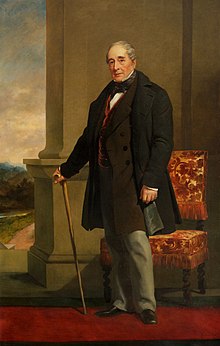Sir Thomas Frankland Lewis, 1st Baronet (14 May 1780 – 22 January 1855) was a British Poor Law Commissioner and moderate Tory (later Peelite) MP.

Early life
editLewis was the son of John Lewis and Anne Frankland, daughter of Sir Thomas Frankland, 5th Baronet. Born in Great Ormond Street, London, he was educated at Eton College, and attended Christ Church, Oxford without taking a degree. His father died in 1797.[1]
Parliamentarian
editLewis was an improving landlord of the family estates in Radnorshire, and was appointed High Sheriff of Radnorshire for 1804–05. He was ambitious to enter national politics as a Member of Parliament, which he did in 1812 as a follower of Lord Bulkeley, at Beaumaris.[1][2]
Lewis was an MP for most years between 1812 and 1855, for Ennis (1826–1828), for Radnorshire (1828–1834) and for Radnor Boroughs (1847–1855). Initially he was known as a Grenvillite; while he supported the landowner and agricultural interest, his sympathy with Catholic emancipation made him unacceptable to the Tory ministry. From 1821 onwards he took the advice of Lord Grenville to establish himself by means of public commission work.[2]
He was elected a Fellow of the Royal Society in 1820.[3]
Commissioner
editOn 24 June 1824, Lewis was appointed to the Royal Commission for inquiring into the nature and extent of the Instruction afforded by the several Institutions in Ireland established for the purpose of Education where he served with the other Commissioners: John Leslie Foster, William Grant, James Glassford and Anthony Richard Blake.[4]
As chairman (1834–1839) of the Poor Law Commission, he immediately clashed with Edwin Chadwick, who had been the driving force for Poor Law reform.[5] Chadwick was Secretary, not (as he had hoped) on the Board itself; and Lewis with George Nicholls and John Shaw-Lefevre proceeded to overrule his views.[6]
Lewis chaired the commission on the Rebecca Riots, and the subsequent commission that abolished the turnpike trusts.[7] He was created a baronet in 1846.
Family
editHe married Harriet Cornewall, a daughter of Sir George Cornewall, 2nd Baronet and Catherine Cornewall. Their family home was Harpton Court, Old Radnor.[8] They had two children:
- George Cornewall Lewis (21 April 1806 – 13 April 1863).
- Gilbert Frankland Lewis (21 July 1808 – 18 December 1883).
References
edit- ^ a b Mandler, Peter. "Lewis, Sir Thomas Frankland". Oxford Dictionary of National Biography (online ed.). Oxford University Press. doi:10.1093/ref:odnb/16605. (Subscription or UK public library membership required.)
- ^ a b "Lewis, Thomas Frankland (1780-1855), of Harpton Court, Rad". history of parliamentonline. Retrieved 1 July 2013.
- ^ "Library and Archive Catalogue". Royal Society. Retrieved 8 November 2010.
- ^ A copy of the Report of the Commission is available at: http://eppi.dippam.ac.uk/documents/9883/eppi_pages/217631 (accessed 18/11/2012)
- ^ Samuel Edward Finer (1952). The Life and Times of Sir Edwin Chadwick. Methuen. p. 118. ISBN 978-0-416-17350-5. Retrieved 10 March 2013.
- ^ John Knott (1986). Popular Opposition to 1834 Poor Law. Croom Helm. p. 65. ISBN 978-0-7099-1532-4. Retrieved 10 March 2013.
- ^ Jerry Dale Lewis (2005). My Neck of the Woods: The Lewis Families of Southeastern North Carolina and Northeastern South Carolina. Genealogical Publishing Com. p. 21. ISBN 978-0-8063-5266-4. Retrieved 10 March 2013.
- ^ Cadw. "Harpton Court (Grade II) (9176)". National Historic Assets of Wales. Retrieved 16 May 2024.